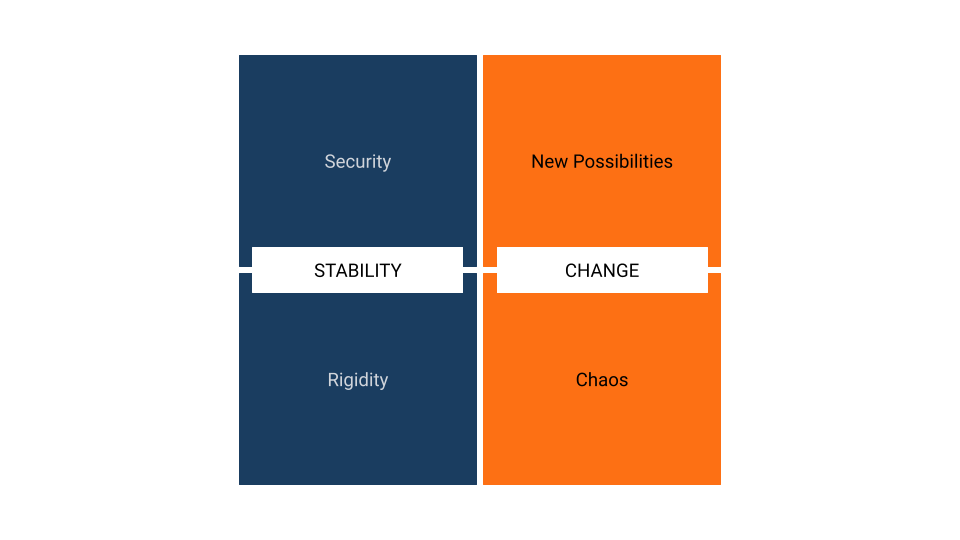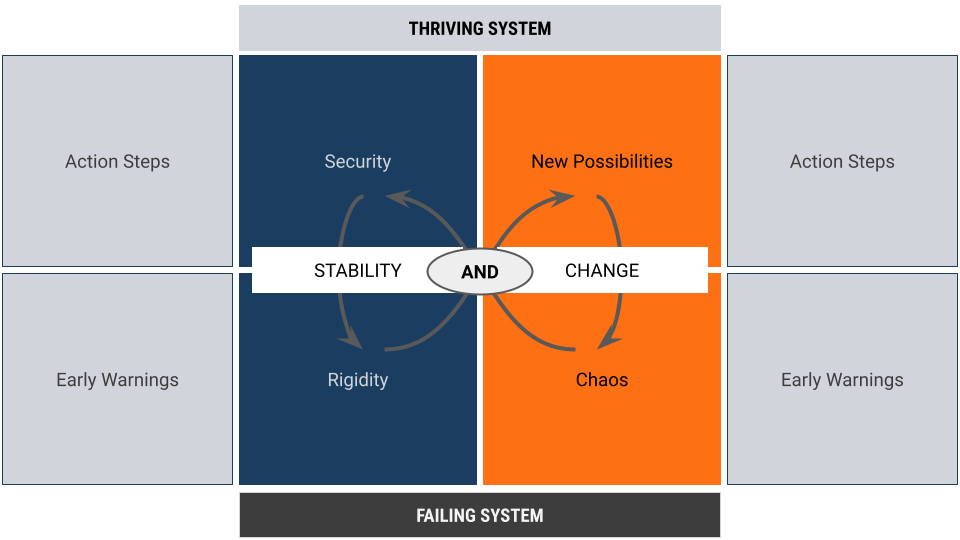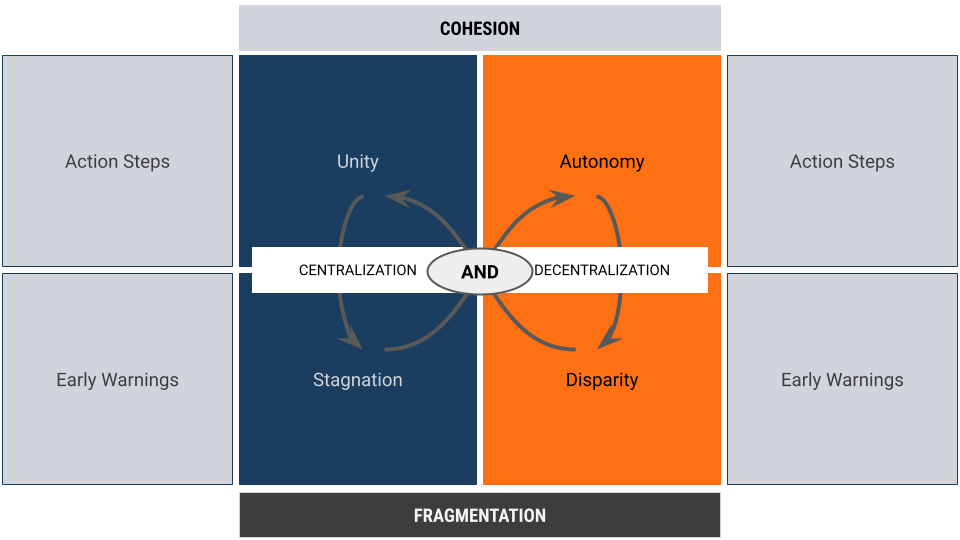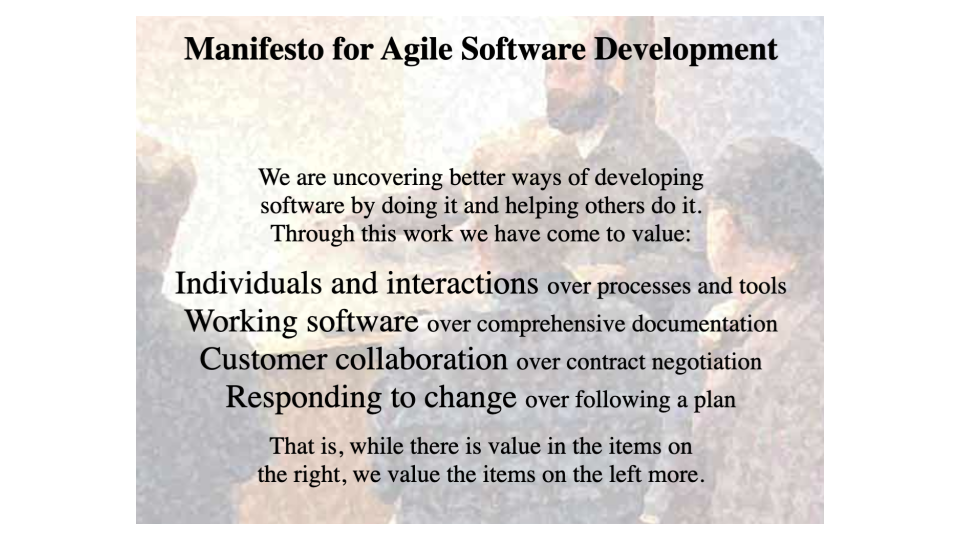Introduction: The tension between stability and change is a constant. It’s a polarity that many leaders grapple with. Embracing both ends of the spectrum can be the key to a thriving organizational system. Polarity mapping is a strategic framework, created by Barry Johnson in 1975, that helps us visualize and manage these opposing forces effectively. Let’s delve into how polarity mapping can be a game-changer in organizational development and personal leadership.
Understanding Polarity Mapping: Polarity mapping is a conceptual tool used to understand and manage polarities or paradoxes within a system. Unlike problems which can be solved, polarities are interdependent pairs that need to be managed. For instance, stability and change are often seen as conflicting concepts, where too much emphasis on one can lead to negative consequences.

The Benefits of Change (upper-right quadrant): Change opens doors to new possibilities, driving innovation and growth. It is the catalyst for adaptation and evolution in a competitive business environment.
The Unintended Consequences of Stability (lower-left quadrant): Stability, while providing a sense of security and predictability, can inadvertently lead to rigidity. Without change, organizations may become stagnant, unable to adapt to new challenges or opportunities.
The Stability Versus Change Paradox: Someone advocating for change may view a focus on stability as an inclination towards rigidity, while a person valuing stability might see change as a precursor to chaos. Polarity mapping enables us to see that the solution to the problem on one side is often found in the strengths of the opposite.
Leveraging Polarity Mapping: The first step in leveraging polarity mapping is recognizing that both stability and change have their own merits. By mapping these polarities, we can work towards a system that harnesses the benefits of both, rather than oscillating between their negative consequences.

Action Steps and KPIs: Once the map is in place, it serves as a guide rather than a definitive answer. The next step involves defining a greater purpose that embodies the advantages of both poles and establishing action steps towards achieving this balance. Early warnings indicators play a crucial role here to indicate when we might be veering towards the negative aspects of either pole.
The Infinity Loop of Leadership: Consider the infinity loop as a visualization of the cyclical nature of polarities. A new manager aiming to introduce change moves from a quadrant characterized by rigidity to one of new possibilities. However, as we become more comfortable with change, we can overlook the unintended consequences of an over-focus on change to the neglect of stability, this can lead to chaos, and the cycle repeats.
The infinity Loop of Centralization and Decentralization: This loop is not exclusive to stability and change; it applies to other polarities such as centralization and decentralization.

Applying Polarity Mapping: Polarity mapping is not just a theoretical construct; it has practical applications. It helps identify if challenges are solvable problems or if they indicate a polarity that needs to be managed.
Balancing Polarities: The Agile Manifesto Example: As we refine our understanding of polarity mapping, it’s helpful to consider real-world applications that embody this framework. A prime example is the Agile Manifesto, crafted in the early 2000s by pioneers in software development. These individuals were responding to the highly process-oriented methodologies of the 1990s, which were themselves an inheritance from traditional, heavy industries like construction.
In those days, software development was heavily weighted towards processes and tools, comprehensive documentation, contract negotiation, and following a plan. The creators of the Agile Manifesto recognized this imbalance and proposed a shift to reestablish equilibrium in the system. They didn’t dismiss the value of the existing methods but suggested that a rebalance was necessary to avoid the pitfalls of an unbalanced approach.

From Precision to Creativity: A Polarity in Software Development
Taking the first value of the Agile Manifesto as an example—“Individuals and interactions over processes and tools”—we can observe a polarity. On one side, processes and tools offer precision, an undoubtedly beneficial attribute. On the other, individuals and interactions foster creativity, which is equally vital. The manifesto’s creators were advocating for a system that appreciates both precision and creativity, rather than one at the expense of the other.

The Agile Manifesto as a Polarity Map: Through the lens of polarity mapping, the Agile Manifesto encourages a balance between the certainty that comes from rigorous processes and the innovation that emerges from human interactions. The manifesto implicitly maps out a path to combine the strengths of both poles:
- Processes and tools represent a structured approach, providing a clear framework and consistency.
- Individuals and interactions signify the human element, essential for collaboration, innovation, and responding to change.
Integrating Agile Principles with Polarity Mapping: The manifesto’s essence is not to invalidate processes and tools but to elevate individuals and interactions to a place of equal importance. It’s a classic example of how recognizing and managing polarities can lead to more effective outcomes. In the case of Agile, this balance has led to more adaptive, responsive, and ultimately successful software development practices.
Embracing Agile Values through Polarity Thinking: By applying polarity mapping to the Agile Manifesto, we gain a deeper appreciation for the nuanced approach its authors were advocating. As we continue to explore and implement agile principles in our work, we should remember the importance of balance and the value of managing polarities to create systems that are not only effective but also resilient and adaptable to change. This enables us to avoid being caught in an infinity loop of alternating between the polarities.
Conclusion: Polarity mapping encourages us to look beyond traditional problem-solving, enabling a balanced focus that promotes a thriving and adaptable organizational culture.

Leave a Reply